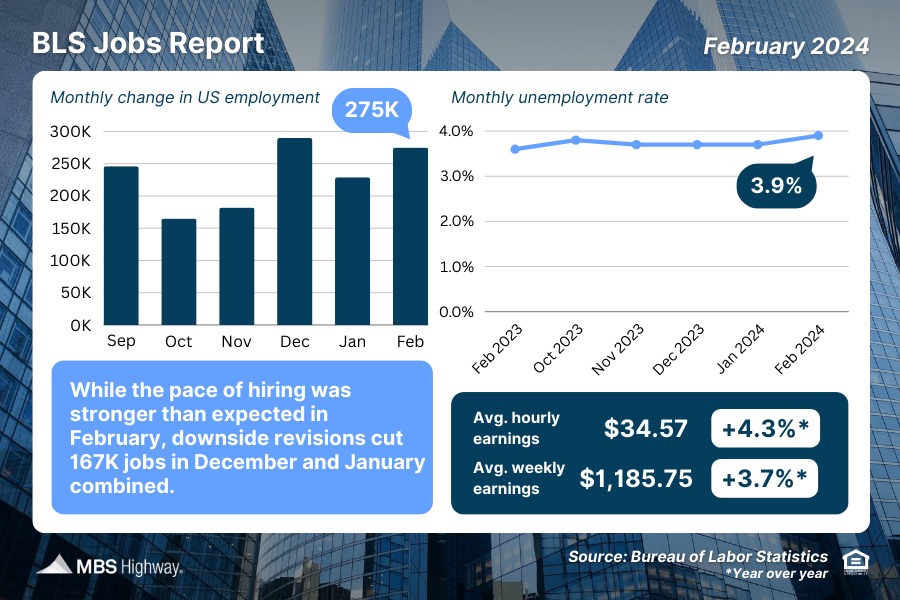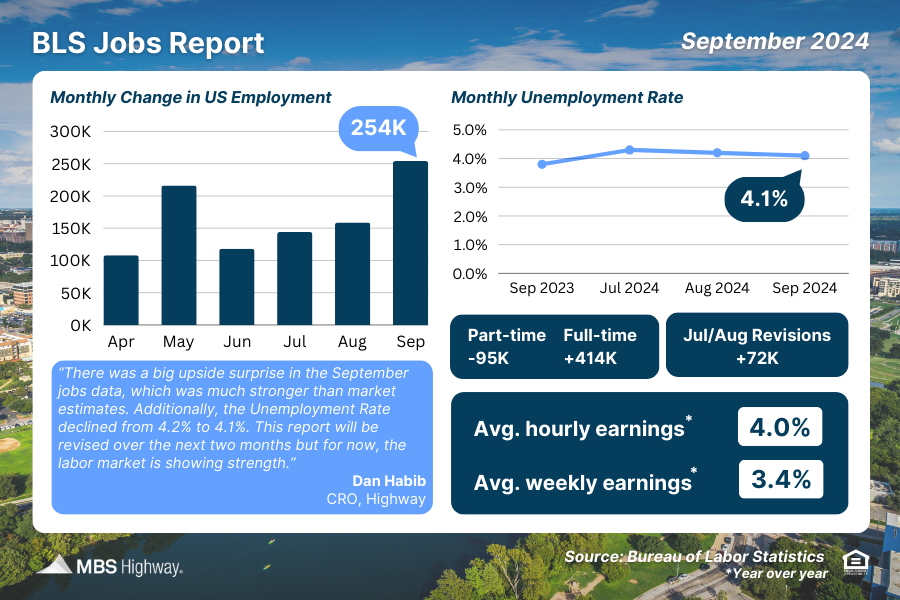Job growth in September was stronger than expected, while the unemployment rate ticked lower. Here…
Real Estate Week in Review for March 11, 2024
There are signs of softening in the labor sector, while annual home price growth continues to show signs of strength. Read on for these stories and more:
-Revisions the Real Headline to Job Data
-Private Sector Job Growth Below Forecasts
-Job Openings Tick Lower in January
-Continuing Unemployment Claims Top 1.9 Million
-Annual Home Price Growth Up at Start of 2024
Revisions the Real Headline to Job Data
The Bureau of Labor Statistics (BLS) reported that there were 275,000 jobs created in February, which was stronger than the 200,000 new jobs that had been forecasted. However, revisions to December and January cut 167,000 jobs in those months combined while the unemployment rate rose from 3.7% to 3.9%, marking the first increase since October.
What’s the bottom line? While the headline job growth figure beat estimates, future revisions lower are a very real possibility, given that we continue to see this pattern from the BLS. Plus, it’s important to look at both surveys within the Jobs Report, which told two different stories regarding job growth.
The Business Survey is where the headline job number comes from, and it’s based predominately on modeling and estimations. The Household Survey, where the Unemployment Rate comes from, is considered more real-time because it’s derived by calling households to see if they are employed.
This Household Survey also has a job creation component, and it showed 184,000 job losses. Plus, February’s report included a sizeable increase in part-time workers (+51,000), while full-time workers fell by 187,000, suggesting some softening in the job market and economy overall.
Remember, the Fed began aggressively hiking the Fed Funds Rate (the overnight borrowing rate for banks) in March 2022 to try to slow the economy and curb runaway inflation. Following eleven hikes in this cycle, the Fed pressed pause at their last four meetings as signs of cooling inflation grew.
While the Fed has stressed that they don’t expect to begin cutting rates until inflation is “moving sustainably toward 2 percent,” a cooling job market is one factor that could encourage members to cut rates sooner rather than later.
Private Sector Job Growth Below Forecasts
ADP’s Employment Report showed that private payrolls grew less than expected in February, as employers added 140,000 new jobs versus the 150,000 that had been forecasted. Most of the hiring took place in the services sector and in businesses with more than 50 employees.
What’s the bottom line? “Job gains remain solid. Pay gains are trending lower but are still above inflation,” said Nela Richardson, chief economist for ADP. On that note, annual pay for job stayers increased by 5.1%. Job changers saw an average increase of 7.6%, which was up from the prior month as pay gains for job changers accelerated for the first time in more than a year.
Job Openings Tick Lower in January
The latest Job Openings and Labor Turnover Survey (JOLTS) showed that job openings declined slightly in January, falling from a downwardly revised 8.889 million in December to 8.863 million. The hiring rate dropped from 3.7% to 3.6% while the quit rate fell from 2.2% to 2.1%, suggesting there’s a lack of employers trying to entice workers with other offers.
What’s the bottom line? The number of job openings may be weaker than the headlines suggest since the rise in remote work has led to job listings being posted in multiple states more frequently. While the Fed watches this report to monitor slack in the labor market, there are flaws in the data.
Continuing Unemployment Claims Top 1.9 Million
Applications for new unemployment benefits were unchanged in the latest week, as 217,000 Initial Jobless Claims were filed. Continuing Claims rose by 8,000, with 1.906 million people still receiving benefits after filing their initial claim.
What’s the bottom line? Initial Jobless Claims are still relatively low, however the latest Job Cuts report from Challenger, Gray & Christmas showed that announced layoffs in February were the highest total for that month since 2009. We could see a bump upwards in future initial claim filings as a result.
Meanwhile, Continuing Claims have been trending higher, with this latest reading being the second highest since November 2021. The data shows that once people are let go it’s more challenging for them to find new employment.
Annual Home Price Growth Up at Start of 2024
Black Knight released their Home Price Index for January, and home values rose 0.2% from December. Prices were also 5.6% higher than in January 2023.
CoreLogic’s latest Home Price Index showed that national home values fell 0.1% from December to January. While this monthly figure was different than Black Knight’s, CoreLogic reported a slightly higher level of annual appreciation, with prices 5.8% greater than a year earlier.
CoreLogic forecasts that home prices will hold steady in February and rise 2.6% in the year going forward, though it’s worth noting their forecasts tend to be on the conservative side historically. For example, CoreLogic originally forecasted that we would see 3% appreciation in 2023 but we saw 5.5%. Plus going back to 2021, they had forecasted a 6.6% decline in home values, and we saw a nearly 19% gain instead.
What’s the bottom line? The annual home price growth seen by CoreLogic and Black Knight has been echoed by other major indices like Case-Shiller and the Federal Housing Finance Agency, showing that great opportunities remain for building wealth through real estate.
Family Hack of the Week
March 13 is National Chicken Noodle Soup Day. Create the perfect comfort food with this quick and easy recipe from Allrecipes that yields six servings.
In a large pot, melt 1 tablespoon butter over medium heat. Add 1/2 cup each of chopped onion and chopped celery and cook until just tender, about five minutes. Add 4 (14.5 ounce) cans chicken broth, 1 (14.5 ounce) can vegetable broth, 1/2 pound chopped and cooked rotisserie chicken breast, 1 1/2 cups egg noodles, 1 cup sliced carrots, 1/2 teaspoon dried basil, 1/2 teaspoon dried oregano, and salt and pepper to taste.
Stir to combine and bring to a boil, then reduce heat and simmer for 20 minutes. Enjoy with your favorite crusty bread.
What to Look for This Week
Inflation will be the key story, with February’s Consumer Price Index releasing on Tuesday and the Producer Price Index (which measures wholesale inflation) on Thursday. The Fed will be watching these reports closely, given that January’s readings were hotter than expected.
Also on Thursday, look for February’s Retail Sales and the latest Jobless Claims. Friday brings an update on manufacturing in the New York region.
Investors will also be closely watching Tuesday’s 10-year Note and Wednesday’s 30-year Bond auctions for the level of demand.
Technical Picture
Mortgage Bonds have been on a nice run higher over the last week and are now trading in a wide range between support at the 50-day Moving Average and overhead resistance at 101.392. The 10-year has been on a trajectory lower and moved down to around 4.08% at the end of last week.






